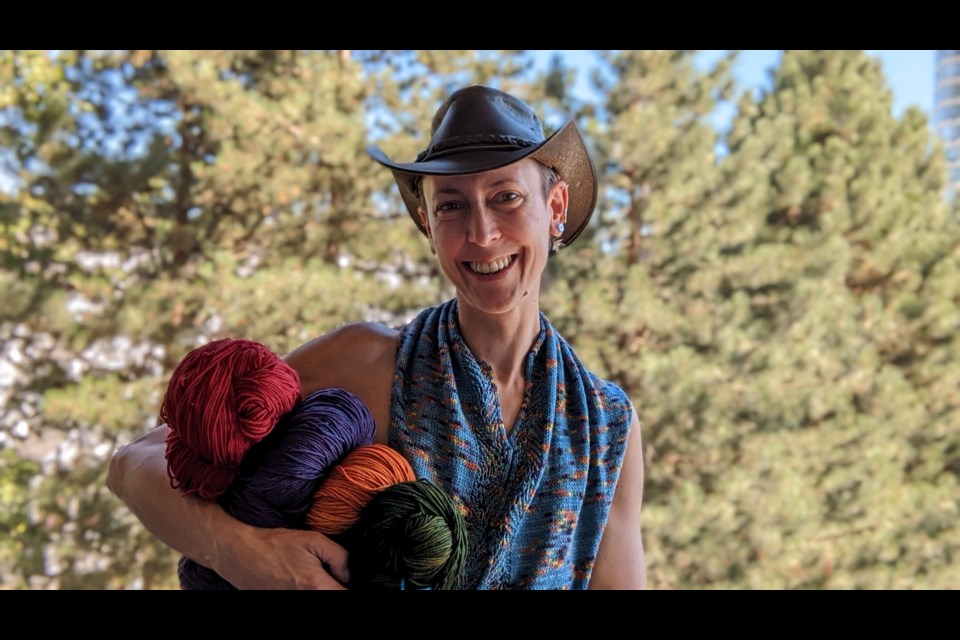Rebecca Glazier’s house in New West is also her work space. Right at the entrance is a neatly arranged row of 14 pairs of cowboy boots; a pole (for pole dancing) rests bang in the middle of the living room, and next to it, skeins of freshly-dyed yarn are laid out on a rack to dry.
The founder of Wild West Dye, which offers knitting kits with naturally-dyed yarn, likes cowboy culture (hence the name, Wild West Dye), and does pole dancing to keep herself fit.
Her love for the two is reflected in the name of the products she sells — like the SpinYouRound cowl and RodeoDream shawl knitting kits.
In the kitchen are three large steel cauldrons — two of them have loosely-knotted yarn threads soaking in boiling water, and another has an indigo solution being prepped for the dyeing process.
Dyeing the way it was done in the early 1800s
We sit next to a yarn ball-winder to chat, and Glazier soon fetches a sack full of tiny samples of different-coloured yarn. On each is attached a label with a recipe.
“Mint is the most difficult dye to make,” she says. “Sometimes I get it, sometimes I don’t.”
It’s a long process that’s not always predictable. But “whatever comes out, it’ll be beautiful,” she says in a convincing tone.
But how challenging can it be to make the mint-coloured dye, really? Unlike synthetic dyes that can be made in a lab (but use “plastics, metals, chemicals that can be toxic”), Glazier’s natural dyes are derived from the colours that are solely found in nature.
For example, cochineal bugs (they come dried in a bottle, and look like black pepper) are used to make fuchsia dye, cream of tartar (a byproduct of wine making) for bright pink, pomegranate fruit rinds for warm cream, marigold flower for vibrant yellow or orange, weld (a type of weed) for yellow, and indigo (a plant) to get shades of blue. All her natural dyes are sourced from the Vancouver-based business Maiwa.
Since there isn’t any root, nut, or bug that’s naturally mint in colour, Glazier has to first treat the yarn with indigo dye to get a light blue shade on it, then follow it up with Myrobalan (a nut from Terminalia Chebula tree) to get mint or shades of teal.
Glazier dyes her yarn the way it was done in the years prior to 1857, when the first synthetic dye was invented.
Each stage of dyeing — from washing the yarn (to get rid of all the oil that might be on it from the spinning machine that processes wool into yarn threads), to mordanting (the process of applying the yarn with a material that ensures that the natural dye sticks on it), to dyeing — takes about two hours each. Once it’s dyed, the yarn has to dry out naturally, which might take around three days.
It’s a more tedious process than synthetic-dyeing but Glazier loves it too much to get frustrated.
Recently, while tidying up her apartment, she had found an old journal of hers from 10 years ago in which she had written ‘Open up a yarn shop’ as her 10-year plan. Though she had forgotten all about writing something like that — subconsciously, she now realizes, she was walking towards that goal all along.
Moving from online store to a physical space
Born in the U.K., Glazier had done fashion and textile design, and innovative pattern cutting in school, and spent 20 years in the fashion industry between U.K. and Sri Lanka, before calling it quits and moving to Vancouver in 2015, doing a workshop on natural dyeing at Maiwa and eventually starting her online store Wild West Dye in April 2020 — which got her closer to her journal plan than ever before.
On Sept. 10, Glazier will, in fact, open her dream store on 20th Street in New West, in partnership with Vancouver-based Baaad Anna’s Yarn Store — it'll be called Baaad Rabbit Fibre Arts.
Glazier, who also teaches knitting through online and in-person classes, and heads a knitting group called Knit1Tea1 for knitting enthusiasts, says the store will have a retail space for her yarn and knitting kits, and a teaching space for workshops.
More importantly, it'll help her debunk the myth that many have about natural dyes — that they are only available in a limited colour palette.
At her new store, you’d see different shades of teal, pink and chocolate brown.
“I love colours,” she says in a matter-of-fact way. A love that was especially nourished in her days living in Sri Lanka for eight years, before moving to Vancouver.
“In Sri Lanka, everything is colourful; people wear so much more colour there than they do in Vancouver. Being in Vancouver where so many people do not wear much colour makes me want to wear more colour just to compensate for the lack of it.”
She wears a bright red coat in winter; a bright yellow raincoat on a grey day — always complementing the look with a pair of cowboy boots from her collection.
“And, I never leave the house without my cowboy hat.”
Check out her online store Wild West Dye, or meet her at her new craft/yarn store on 804 20th St. when it opens on Sept. 10. If you buy a rainbow shawl kit from Wild West Dye, a part of the pay will go towards the treatment (Neurological and Physical Abilitation program and Stem Cell therapy) of Glazier's granddaughter in the U.K. You can also donate directly at Just4Children website.



